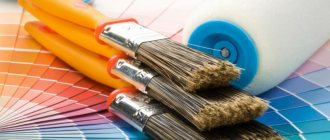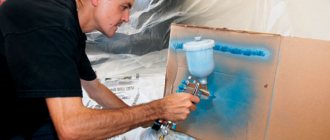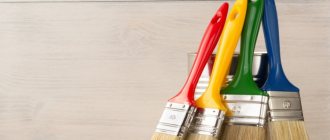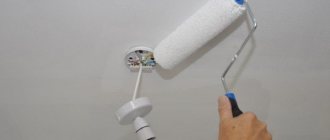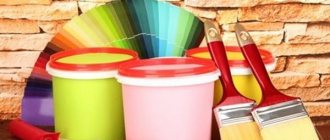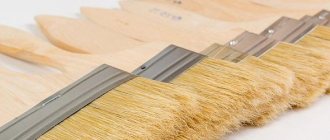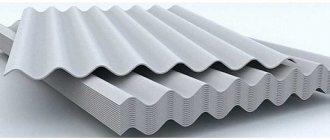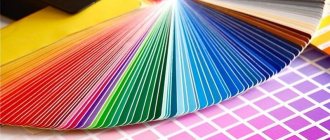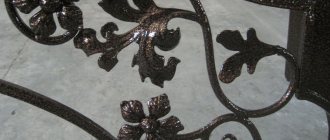Paint brush: types, sizes and care rules
A paint brush is a simple but multifunctional tool that is used in various types of finishing work: painting surfaces, applying putty, primer, and adhesive mixtures.
For all of the listed types of work, there are other tools - for example, rollers, spray guns, but only using a brush can you carefully draw a line, apply paint to hard-to-reach areas, and avoid its splashing.
In order for the tool to be comfortable to work with, you need to choose the right type of paint brush. We will talk about the types of products, the features of their selection and use in different types of work below.
Types of brushes
There are many types of paint brushes, which differ from each other both in design, size, and bristle length. These differences play a significant role when choosing the right tool for a particular type of finishing work, and therefore it is advisable to be able to understand the types of brushes and their purpose in order to choose a painting kit for the upcoming repair correctly. The main types of products are:
Handbrake (KR, KRO, KRS)
These products usually have impressive dimensions (the size of the brush can reach almost 30 centimeters), and the bristles are secured to a short handle with a thick metal rim. Traditionally, tools of this type are used in priming or painting small surfaces. It is recommended to use hand brushes when working with slow-drying paint or primer mixtures that do not contain solvents. The main advantage of the products is their increased resistance to aggressive substances.
Handbrake
Trimming brushes (ШТ)
They are used in work when there is a need to create a roughness effect on a base coated with paint. To achieve the desired result, the brush requires constant care; it must be perfectly clean. Moreover, work with a tool of this type is structured in a special way: the paint is applied with single, sweeping strokes using ShT brushes. Trimming brushes can only be used on already painted surfaces!
Trimming brush
Mack brush (KMA)
This tool can have a round shape (the diameter of the ink part is up to 170 millimeters) or rectangular (width up to 200 millimeters). They are valued for their high productivity and the absence of the need for additional leveling (flattening) of the surface after painting with paint. The tool can only be used for water-based paints or aqueous solutions.
Brush
Fly brushes (KM)
They are used both for painting substrates and for washing and whitewashing them. The tool is convenient to work on large areas. Products are made from natural hair with a small addition (no more than 30%) of synthetics. The key advantage of this type of instrumentation is its high resistance to moisture, solvents, and other aggressive paint and coating components.
Flying brush
Flute brushes (KF)
Designed for work on leveling the coating on already painted surfaces. Using brushes allows you to smooth out the roughness of the strokes from the initial coloring. They can also be used as an independent tool if there is a need to create a final glossy layer.
File brushes (FKF)
This tool is small in size, the diameter of the ink part does not exceed 18 millimeters. The use of small brushes is advisable when you need to draw a neat and narrow line; most often the tool is used to create a harmonious transition at the junction of bases painted in different colors.
Flat brushes (KP)
A popular type of product is flat brushes (FB), used in painting, priming work, and when applying varnish compositions to the base. The tool is produced in a wide range of sizes - from 35 to 100 sizes. Size in this case means the width of the handle of the product. The bristles of flat brushes always have a cone shape.
Swing brushes
This type of material has a large diameter (about 6 cm), and the beam length reaches 10 cm. This tool is intended for painting or whitewashing large areas. The fly brushes in the form of a bundle are tied to another material, thereby adjusting its length.
The quality of this tool is determined by the ability of the material to take its original shape when bent. This type is very convenient to use: for example, the bristles can withstand contact with aggressive substances and solvents.
Care instructions
You not only need to be able to work with a paint brush correctly: the tool requires maintenance so that it does not lose its useful functionality after the first use. If there is a long break during the painting process, the brushes should be soaked in a container of water during the break.
After completing the work, the tool is thoroughly washed in special solutions that will remove any remaining paint from the pile, and dried.
You can clean the pile of the product with regular soda. To do this, place the brush in a container with baking soda and hold it for a while. Afterwards, the bristles are thoroughly rinsed in clean warm water and dried.
To prevent the bristles of the tool from losing its softness, it is recommended to wrap the brush in thin parchment paper.
We hope that the information presented to your attention in this article helped you obtain useful information about the paint brush and understand the types and rules of working with the tool.
Source
Paint brush: types and sizes
A paint brush is a tool that is most widely used in all kinds of paint and varnish work. Its production does not require large time and material costs. Before starting work, brushes that have never been used should be soaped and soaked to soften the bristles. The service life of the tool will increase if the bristles are moistened with linseed oil.
Handbrush
This type is used for painting small areas, such as windows or pipes. The diameter of the brushes reaches 6 cm. The tool is made from natural bristles and horsehair. Since the center of the painting tool is empty, it accumulates paint. It is not recommended to use a round paint brush for glue or lime mortar.
Types of brushes
Let's look at the most popular types of brushes.
Brush handbrake
Handbrake brushes (KR) are large in size; the bristles of such a tool are attached to a short handle with a metal rim. In cases where the fibers are too long and do not allow you to work normally with glue or oil paint, they are tied with twine.
In the photo: handbrake
Trimming brushes
Trimming brushes (CT) are used when it is necessary to give a rough-matte appearance to freshly painted surfaces. Before, after and during work, the brush must be as clean as possible, so it must be periodically moistened and wiped. When using this tool, it is recommended to apply single precise blows to the surface being treated.
In the photo: trimming brush
Maklovitz brush
Poppy brushes (KMA) are either round (diameter up to 170 millimeters) or rectangular (width up to 200 millimeters). They have great productivity and are able to perform painting work with a high level of quality. Paint brushes are used for aqueous solutions.
Maklovitz brush
Flying brush
The flywheels (FM) are round in shape. They are used for priming, whitewashing, washing and painting various surfaces, in particular those that have a large area. To paint hard-to-reach areas, workers often attach long sticks to such brushes themselves.
In the photo: fly brush
Panel brush
Filenochny (KF), have the form of round flat tassels, the diameter of which does not exceed eighteen millimeters. Needed to draw straight stripes and draw narrow lines when finishing.
In the photo: file brush
Radiator brush
Radiator brushes have a design that facilitates penetration into hard-to-reach places; they are often used for painting radiators and other similar surfaces.
In the photo: radiator brush
Proper care
Caring for any of the types of paint brushes listed above does not require special knowledge. It is enough only to immerse them in containers with water during breaks in work, and after use, rinse them in special solutions, dry them and store them wrapped in paper.
Maklovitsy
Maklovits are used for applying glue or liquid paint. The shape of the material can be round (10 cm in length) or rectangular (8 cm in length). The length of the bristles is about 10 cm.
The layers of the solution are applied evenly, since the bristles contain horse hair on one half and nylon on the other. The composition of the material and careful handling of the tool guarantee a long service life.
How to paint with a brush
Who among us has not held a regular paint brush in our hands? It would seem that this simple instrument does not hide any secrets. However, when working with it, there are a number of points that should be discussed separately
Paint brushes are made from natural pig bristles and from various synthetic fibers. Most often these are threads made of nylon or polyester. Natural brushes are better suited for working with alkyd and oil paints, while synthetic brushes are good for painting with acrylics. Before starting work, the new brush should be washed with warm soapy water and dried. This procedure will remove dust and broken fibers that can degrade the quality of the paint job.
How to paint with a brush
You should not dip the brush all the way into the paint can. It is better to limit yourself to approximately half the length of the pile, and then, by gently tapping the inside of the can, get rid of excess paint on the brush. Never smear excess paint from the brush on the can! This will disrupt the uniform layer of paint on the pile and the dyeing process will become more complicated. Also, there are different rules for painting for different materials, for example, the ceiling should be painted from the darkened side, towards the window, and when painting wood, the movements of the brush should follow the grain.
Flute brush
Flat brushes for painting, made from pig hair. In some cases, pig hair and half horse hair are secured with a metal plate on a wooden or plastic handle. Particularly expensive brushes are made from badger hair.
A flute brush is suitable for painting flat, even surfaces; it can also be used to paint a construction corner. Initially, the use of a brush was limited to removing excess drips of freshly painted paint.
The sizes of painting brushes come in a wide variety of sizes from 2 cm to 20 cm. Among them you can find a brush suitable in size for the required type of work.
The table provides a more succinct description of the names of flat paint brushes and round paint brushes.
Brush size
Many of us do not think about such a seemingly trifle as the size of a paint brush when carrying out painting and painting work.
Naturally, this statement does not apply to professional builders - painters, but is relevant for the average ordinary person, the category that you and I belong to.
As a rule, if we are planning to paint and update something, we:
We take into account, first of all, the coating itself that we will use (paint, varnish, emulsion) and focus more on the type of coating itself and / or its color, rather than on what tool we will use to perform the intended work .
Leaving this issue without due attention, and remembering that somewhere in the pantry with a jar of water or, at best, a solvent, we have some brushes that were left over from the last, or even the year before, renovation. Thus, making a serious mistake, which subsequently manifests itself when the painted surface dries in the form of brush hairs remaining on the fresh paint and, most importantly, visible brush marks that “crawl out” beyond what we wanted to paint.
This is all due to the incorrectly selected type and size of paint brush used.
So, in order to avoid such incidents and not be upset when you see the result of the work we have done, you should know for which surfaces to be painted one or another size of paint brush is used.
Currently, in construction stores you can always find and purchase brushes of the following sizes:
For all brushes, the numerical size (in millimeters) refers to the width of the working part of the brush, that is, in fact, the width of one stroke, which is obtained when applying the paint composition.
In addition to size, paint brushes are divided into those whose working part is created using artificial or natural bristles, and there is also a difference in the material of the brush handle, which can be made of plastic or wood.
Standing apart from the list of painting brushes are radiator brushes and brushes of the “maklovitsa” type, which are more suitable for applying water-based compositions.
Let's consider the first type, a paint brush measuring 25 millimeters.
This brush is used when painting or varnishing thin surfaces, no wider than a matchbox. Such surfaces include various glazing beads, metal or wooden rods with a diameter of no more than 15 millimeters, as well as other rather delicate parts and surfaces.
The 38 mm brush is suitable for painting round surfaces with a diameter of no more than 32 mm, ceiling cornices and skirting boards no more than 5 centimeters wide, as well as the internal surfaces of the edges of window frames.
Paint brush with a working size of 50 millimeters, suitable for applying paints and varnishes to standard skirting boards and window frames. This is also the perfect brush size for painting stair railings.
Brushes measuring 63 and 75 millimeters can be successfully interchanged and are perfect for painting:
Also, this brush size is a good option for painting fences, as well as benches, greenhouses and other outbuildings.
The largest of the sizes presented, 100 millimeters, will serve as a good tool for:
The best paint brushes for perfect painting with natural bristles
PQtools Premium
The stylish professional flat brush has a two-component plastic handle. The ergonomic shape reduces the strain on the hand during operation. A special hanging hole makes storage easy. The unique Chungking material was used in production. In production, it went through several stages of processing and strict sorting for defects. The material absorbs and holds paint well and distributes it evenly. The stainless steel bandage securely holds the pile.
PQtools Premium brush
Advantages:
- beam density: 80 - 90%;
- ergonomic handle;
- stainless steel bandage;
- compatibility with all types of impregnations, paints, glazes, oils and other substances;
- elastic natural bristles;
- A cardboard hanger is included.
Flaws:
- too expensive;
- low service life.
Anza Perfect
Professional equipment from a world famous company. Used for applying paint and varnish material to large areas and hard-to-reach places. The classic design will appeal to many craftsmen. A simple and comfortable wooden handle equipped with a hole for hanging.
Anza Perfect brush
Advantages:
- stainless steel rim;
- classic design;
- treatment of hard-to-reach places.
Flaws:
- focus on painting wood;
- not the best solution for working with water-based paints.
KRAFTOOL ERGO 120mm, 1-01041-79
Priming, whitewashing, working with all types of paintwork materials, processing large surfaces, applying glue to wallpaper and washing the ceiling. For relatively little money, the user receives a universal device that can handle almost all tasks. The highlight of the ERGO series is the two-component rubberized plastic handle. It is durable, comfortable and does not slip out of your hands. The handle is resistant to aggressive chemicals and is easy to clean. When developing a stainless steel bandage, the designers set themselves the goal of avoiding lint loss.
brush KRAFTOOL ERGO 120mm, 1-01041-79
Advantages:
- ergonomic handle;
- the edge of the handle is equipped with a hook for hanging;
- double-sided grip for fixing the bucket on the edge of the bucket;
- stainless steel bandage;
- versatility;
- German quality.
Flaws:
- quickly disappears from shelves, it may be difficult to find this model;
- It is difficult to work with viscous, dense compositions.
Types of brushes
Note: Spine bristle brushes are shaped like a cone, which allows them to capture more paint and apply it evenly to the surface.
Types of bristles
Natural fiber bristles are ideal for painting work; they hold the composition well, applying it in an even layer. It feels a little rough to the touch, which allows it to absorb more paint. This is what distinguishes it from artificial (nylon) hairs.
Bristles made of synthetic materials consist of polymers and have a small thickness. Different types of modern polymers allow you to achieve the desired rigidity. Nylon polyester bristles are perfect for water-intensive paints; their hairs do not absorb the paint material; nylon repels moisture and retains its original structure. In addition, nylon is better suited for painting timber without leaving lint on it.
Mixed bristles are usually considered to be those that consist of natural and synthetic fibers (usually nylon). This approach improves the elasticity and wear resistance of the paint brush.
Types of pile
When working with paint, it is best to use natural bristle brushes. They differ from nylon brushes in that the bristles are much rougher, thanks to which they pick up more paint and distribute it evenly over the surface.
Nylon brushes are made from various materials to achieve a fine bristle structure. Nylon brushes retain their shape well even after several uses. Excellent for painting wood.
Brushes, half consisting of natural fiber and nylon, thanks to this composition, the wear resistance of the brush significantly increases.
Proper brush care: tips
If you care about your tools and want them to serve you as long as possible, then you need to follow certain rules for their storage and use. New or unused paint brushes should be washed with hot water and a little soap to remove dust and broken fibers from the bristles. After this, the bristles are squeezed out and dried.
Before starting painting work, it is necessary to soak the bristles so that they absorb moisture, softening and increasing in volume. In this simple way you can achieve a smoother and more even application of paint.
Before starting painting work, the tool must be developed so that it takes the correct shape. To do this, take a little paint mixture and the brush itself; use any rough coating (brick, plaster, concrete) as a test surface. This way, the hairs will find the correct shape for further work. It is better to clean the working surface of all excess.
It is very important to use the tool correctly. For example, a round brush on a work surface should be gradually rotated in your hand so that its hairs are erased evenly. You don't need to press it hard.
There are times when a person is simply physically unable to work through the entire surface. Naturally, he needs rest. At this time, the brush can be left in the paint or immersed in a special solution. If glue, lime, oil and casein solutions are used, then soak the tool in water. For kerosene, turpentine or drying oil compositions, it is recommended to use special solvents.
Very important: You do not need to immerse the brush completely, but only to the depth where the bristles lightly touch the bottom, otherwise the hairs will bend or break; it is best to hang them on a wire or other device.
How to wash your brushes? To do this, take kerosene, and then use water and soap. Such simple procedures should be continued until the water stops being colored, remaining clean. At the final stage, we hang them up and dry them. The cleaning process is complete.
How important is brush shape?
Most people are used to saving their resources by using old tools since time immemorial, but this is completely wrong. You just think you're saving money, but you're not. For example, you can paint one surface all day with a small round bristle brush. It is much more profitable to purchase a large flat brush, which will paint an impressive surface in one stroke.
A small round brush is more suitable for a small work surface. This tool allows you to coat special areas such as round pipes. For hard-to-reach places, it is recommended to use so-called angled brushes. It is important to remember that, first of all, you save time.
How to choose the right painting tool?
Before purchasing a tool, the question arises: how to make the right choice? In fact, there is simply no multifunctional brush; different brushes are used for each situation. Builders prefer to use natural materials rather than polymers, but natural fibers are not always better than nylon. For example, synthetic brushes are purchased for mixtures with a water base; their nylon hairs tend to repel moisture. A round brush is good for small areas, while flat brushes are good for walls and other flat surfaces.
Source
The Best Paint Brushes for Perfect Paint with Synthetic Bristles
Anza Elite PRO XT 160450/70
The Elite PRO series was developed taking into account the wishes of professional painters, for whom not only high performance characteristics are important, but also ease of use. The abbreviation XT indicates that the tool has a short and curved shape, aimed at finishing wood, doors, walls and ceilings. They absorb paint well and leave an even layer upon contact. This significantly saves time and reduces paintwork costs. We selected the optimal length for the job. The model received a high-strength wooden handle made of Chinese cherry.
brush Anza Elite PRO XT 160450/70
Advantages:
- curved shape;
- compatibility with any type of coatings;
- long service life;
- stainless steel rim;
- made in Sweden.
Flaws:
- Interior finishing of wooden surfaces is recommended.
Pentrilo Velourex triangular
The first thing that catches your eye upon a quick inspection is its unusual shape, triangular. This decision is due to its functional purpose. With it, maximum efficiency is achieved when applying precise strokes, thin and elegant lines, and the processing of corners is facilitated. The fiber used is Velourex fabric. It shows good results when interacting with synthetic and water-based enamels. The fabric is easy to wash. The structure is held in place by a stainless steel rim.
Pentrilo Velourex triangular brush
Advantages:
- fiber memory;
- easy cleaning;
- two-component rubberized handle;
- pendant in the shape of a hook, it can be used to open cans of paint;
- strong and durable tool.
Flaws:
- reveals itself well when interacting with water-based paints.
Harris Brushes Premier
The company has developed a unique technology that reduces lint loss to zero. This is largely due to the stainless steel frame. The best solution for painting walls and ceilings. The collection of coloring material has increased significantly due to the split ends of the villi.
Harris Brushes Premier
Advantages:
- wooden handle;
- steel frame;
- made in England.
Flaws:
- with intensive use it quickly becomes unusable.
Varieties
A standard paint brush is a handle made of wood or plastic, to which a tuft of natural or artificial bristles is attached using a special bandage. Bristles can have different hardness, length and thickness of hairs. Working with a brush is very simple: the tip of the tuft is saturated with paint, after which the paint is smeared over the surface, but do not press the brush too hard to ensure an even coating.
Despite the simplicity of this tool, there are several parameters by which they can be divided into different types.
Brushes are distinguished according to the following parameters:
Working part shape
According to the shape of the working part of the brush, they are divided into two types:
Work surface size
According to this parameter, brushes are divided into three types:
By type of bristles
Based on material, brushes are divided into three types:
In addition to the general classification of brushes by type and material, there is a division of brushes by type of work. To understand what purpose a brush is best suited for, you need to read its labeling.
Classification of brushes by purpose
By purpose, finishing tools are classified as follows:
